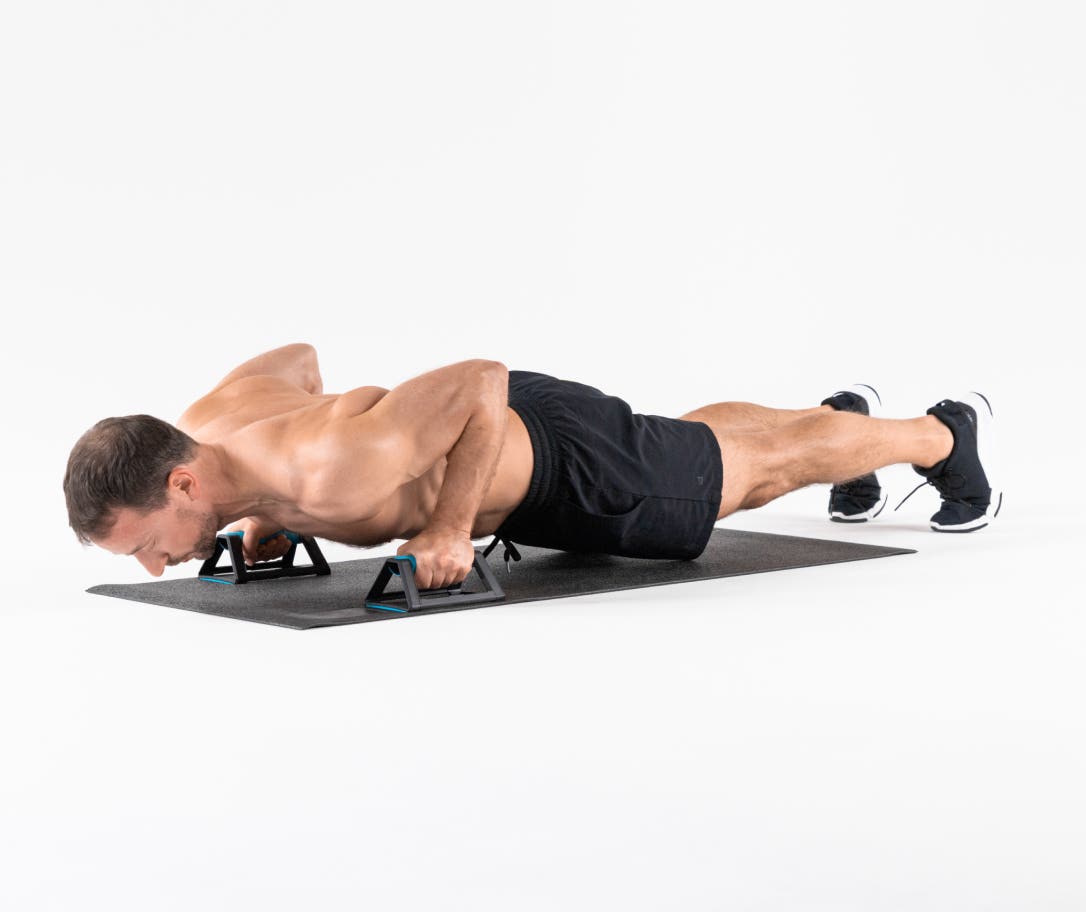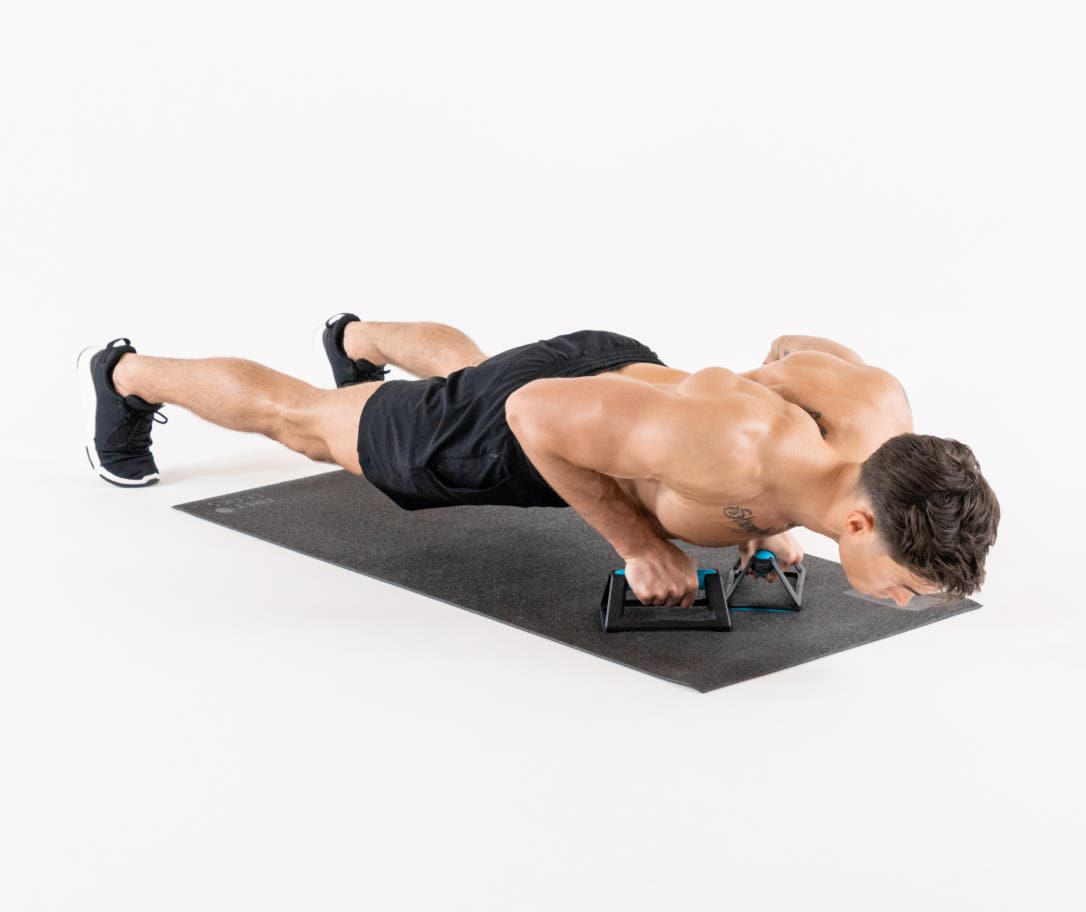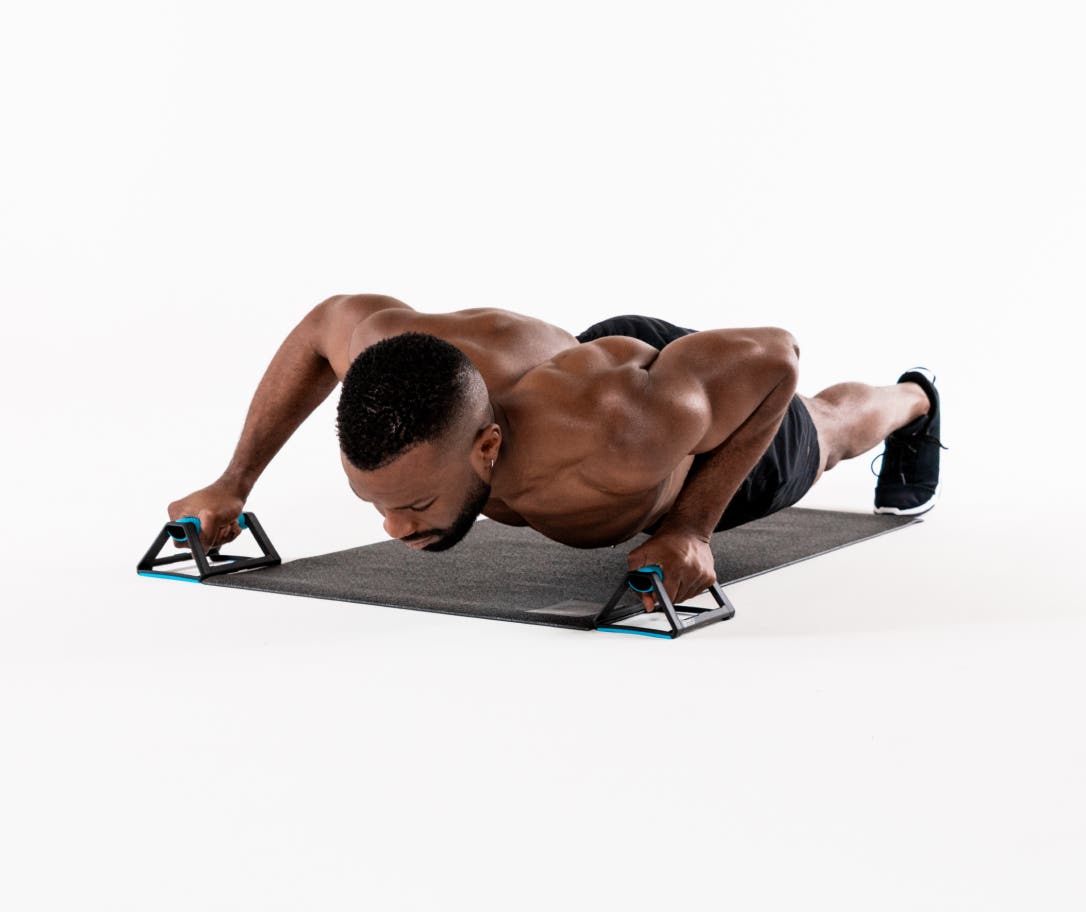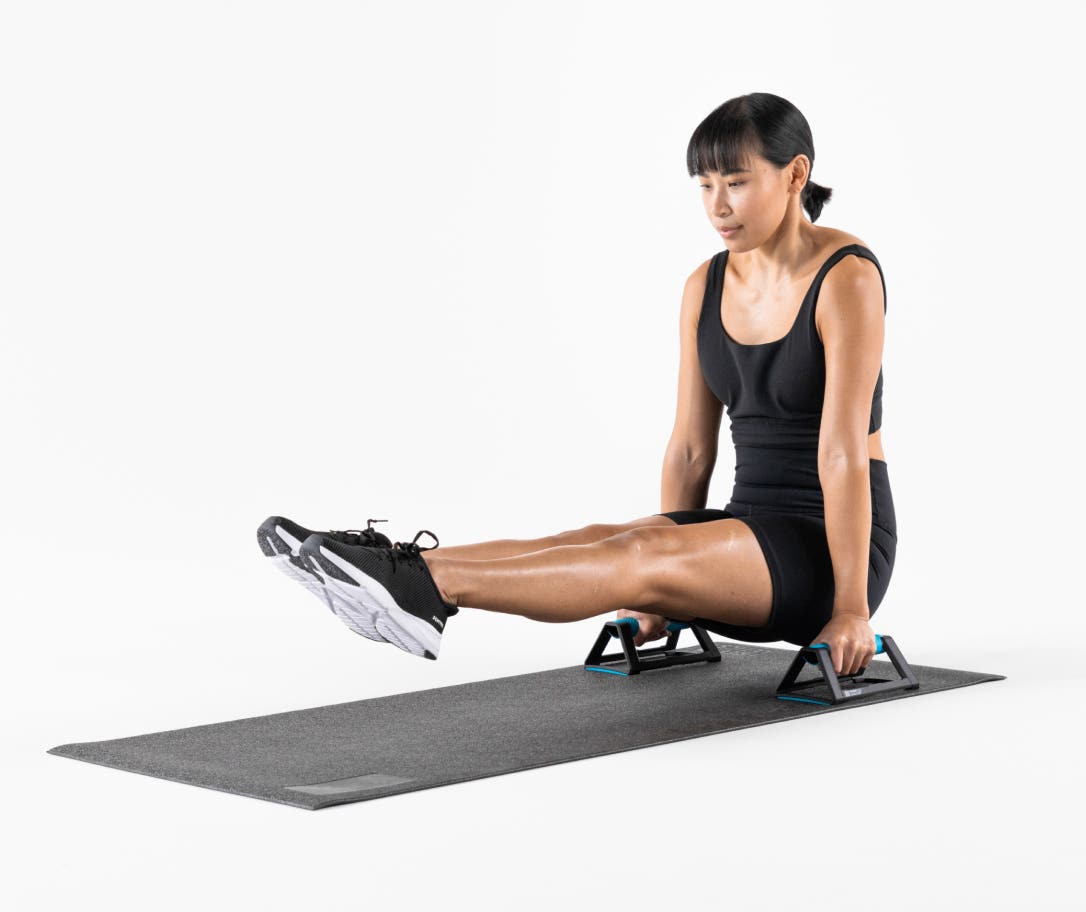Pushup bars are small, portable exercise tools designed to elevate your hands during Pushups. Typically made of metal or sturdy plastic, these bars feature a grip handle on a stable base, allowing you to maintain a neutral wrist position.
By raising your hands off the ground, bars offer new challenges and benefits that floor Pushups cannot match.
What are the benefits of using pushup bars?
Less stress on the wrists
One of the most significant advantages of pushup bars is the relief they provide to your wrists. In standard Pushups, the wrists are extended at about a 90-degree angle, which can cause discomfort or pain – especially over time or for those with existing joint issues.
Bars let you maintain a more natural, neutral wrist position, similar to how you might hold a free weight. This reduces strain and lowers the risk of overuse injuries.1
More mobility and depth
Another major benefit is the increased range of motion. Since your hands are elevated off the floor, you can lower your chest below the level of your hands, deepening the Pushup.
This extended motion recruits more muscle fibers, particularly in the chest and shoulders, leading to greater strength and muscle mass development.2 This deeper movement can support flexibility and joint mobility over time if performed with proper technique.

Drawbacks
While using pushup bars in resistance training offers many benefits, they do present a few drawbacks, especially for those who are just beginning their fitness journey.
First and foremost, you’ll need to have a foundational level of upper-body strength and control. Because the bars elevate your hands, they allow you to bend your elbows past the typical 90 degrees, letting your torso drop lower than a Pushup with your hands on the floor.
While this added depth leads to better muscle activation, it also demands more from your chest, shoulders, triceps, and core stability. For beginners or those with limited upper body strength, even a few reps can be quite difficult.
Additionally, the elevated position creates a slight instability that requires more control and stability throughout the movement.
If you lack the requisite strength or coordination, there’s a higher risk of breaking form, which can potentially lead to strain or injury – particularly in the shoulders or lower back.
Finally, those with shoulder mobility limitations or preexisting conditions should approach bars with caution. The deeper range of motion, while beneficial for most, might place extra stress on the shoulder joint if not performed with proper technique and progressive adaptation.

4 training tips
To make the most of bars – and to do so safely – it's important to approach training with intentionality and awareness. Here are a few things to keep in mind:
- Expect fewer reps at first: The increased range of motion and muscle engagement from using pushup bars means your muscles will fatigue faster. Don’t be surprised if you can’t get in as many reps as you can with regular Pushups. This is not a sign of weakness but rather an indication that you're challenging your muscle strengths more effectively. Focus on quality over quantity, ensuring each rep is controlled and full-range.
- Keep full-body tension: Many people assume Pushups are purely an upper-body exercise, but a proper Pushup is a full-body exercise. Engage your core, glutes, and legs to create a rigid, plank-like posture from head to heels. This tension not only stabilizes the movement but also prevents form breakdown, such as sagging hips or arched backs, which can compromise performance and safety.
- Warm up beforehand: Try activating your wrists, shoulders, and chest before exercising, especially if you're doing deeper or more dynamic variations.
- Progress gradually: Incorporate a gradual progression of difficulty. Starting with Incline or Knee Pushups and working up to advanced movements ensures that your body adapts properly over time.
By approaching pushup bar training with patience and precision, you'll see faster gains in strength, control, and muscular endurance, all while minimizing the risk of injury and ensuring proper form.
Exercises for all levels
Pushup bars can be used for a wide range of exercises, from push-up variations to advanced calisthenic holds. Here are some great options available in the Freeletics app, categorized by skill level:
Beginner exercises
- Incline Pushups: Place the bars on a raised surface and perform the movement at an incline to reduce difficulty.
- Knee Pushups: Place your knees on the floor while gripping the bars to adjust to the new wrist position.
Intermediate exercises
- Pushup Bars Pikes: Start in a high plank position and pike your hips up while keeping your arms straight, creating an inverted V shape. This targets the shoulders and core.
- Pushup Bars Side-to-Side Pushups: Move your body laterally during each rep to shift load between arms, increasing muscle coordination and unilateral strength.
- Pushup Bars Diamond Pushups: Place your hands close together on the bars to target the triceps and chest more intensely.
- Pushup Bars Decline Pushups: Elevate your feet to shift more of the load to the shoulders and upper chest.

Advanced exercises
- Pushup Bars L-Sits: Support your body weight on the bars with legs extended in front of you. This isometric hold develops core strength and control.
- Pushup Bars Diving Pushups: Mimic a yoga dive-bomber motion, swooping your chest forward and upward through the bars. This improves shoulder mobility and strength.
- Pushup Bars Archer Pushups (Right and Left): Keep one arm extended while the other performs a pushup, focusing strength on one side at a time. Great for unilateral strength.
- Frogstand: Balance your knees on your upper arms while holding the bars. This skill builds balance, coordination, and core engagement.

Mistakes to avoid
Using pushup bars effectively means avoiding a few common pitfalls:
- Rushing the movement: Pushup bars allow for deeper motion, so take advantage of it by moving slowly and with control.
- Letting hips sag: Always maintain a neutral spine and tight core. Sagging hips reduce the exercise’s effectiveness and can increase injury risk.
- Neglecting progression: Don’t jump into advanced variations too soon. Start with the basics and build strength gradually with different variations to avoid strain or poor form.
- Overtraining wrists or shoulders: Even though using bars reduce wrist stress, they shift more load to the shoulders. Pay attention to joint health and avoid overuse.
Let’s recap
Pushup bars reduce wrist strain, enable deeper and more effective Pushups, and open the door to a range of challenging bodyweight exercises. With thoughtful progression and attention to form, these simple tools can significantly elevate your strength training – no matter your fitness level.
So grab a pair, focus on form, and push your limits – literally and figuratively. Integrating them into your workouts might just be the shift you need to build strength safely and effectively.
Sources
[1] American Council on Exercise. (2018). The benefits of bodyweight training. Available here
[2] McGill, S. M. (2010). Ultimate back fitness and performance (4th ed.). Backfitpro Inc.